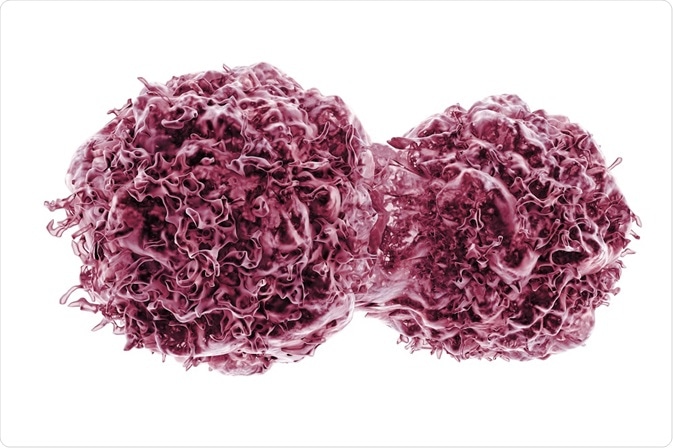P53, the gene product of the TP53 gene, is a fundamental protein involved in the suppression of tumorigenesis. This gene was initially described in 1979, originally thought to be a proto-oncogene. However, subsequent research proved it to be a tumor suppressor gene.

Credit: Kateryna Kon/Shutterstock.com
The loss-of-function mutations in this gene are responsible for various kind of tumors. The p53 protein is known as “the guardian of the genome” or “cellular gatekeeper” as it ensures the stability of cell by preventing the replication of cells with mutated DNA.
Cell cycle and check points
In order for a cell to divide into two daughter cells, it must first copy its DNA. This is carried out in a highly controlled and ordered process called the cell cycle. There are four distinct phases of this cycle; gap 1 (G1) phase, DNA synthesis (S) phase, gap 2 (G2) phase and Mitosis (M) phase. Progression to each phase is stimulated by mitogens and growth factors.
Progression is also controlled by specific check points, to ensure that the critical events at each phase are completed before the cell can move to the next phase. For example, at the G1 checkpoint, the retinoblastoma (RB) protein has a critical role.
This protein sequesters transcription factor E2F and therefore prevents the transcription of DNA. Phosphorylation of RB by cyclin dependent kinases (CDKs) 4 and 6 prevents binding of RB to E2F, meaning this transcription factor can induce transcription and the cell can pass through the G1 check point. Therefore, a cell can only pass into S phase if the amount of active CDK 4 and 6 reaches a certain threshold.
The role of TP53 in the cell cycle
During the cell cycle, p53 monitors the integrity of the genome. When DNA damage is detected, p53 is phosphorylated by various protein kinases such as ataxia telangiectasia and Rad3 related (ATR), DNA dependent protein kinase(DNA-PK), ataxia telangiectasia mutated (ATM), checkpoint kinase 1 and 2 (Chk1 and Chk2) at Serine15, Threonine18 or Serine20, respectively.
In a normal cell, p53 is not phosphorylated and MDM2 binds to p53, maintaining it in this inactive form by preventing it from binding to DNA. The ubiquitin system further targets the protein for destruction. However, once phosphorylation of p53 takes place, MDM2 binding is disrupted and p53 is stabilized, resulting in a dramatic rise in p53 levels. The p53 then binds sequence-specifically to DNA via the transactivation domain and upregulates or downregulates target genes.
One example of a target gene is p21. This is a cyclin-dependent kinase inhibitor is upregulated by p53 and inhibits CDK 4, 6 and 2. As the CDKs are required for phosphorylation of the RB protein, hence inhibition results in arrest at the G1 check point.
p53 can also arrest cells at the G2/M checkpoint, which is usually driven by CDC2 and cyclin B1. Once bound to DNA, p53 upregulates the transcription of numerous proteins, including p21, GADD45 and 14-3-3σ, which inhibit CDC2 and therefore, prevent cell cycle progression into M phase.
Once the cell cycle is halted, p53 can then activate genes involved in DNA repair or, if the DNA is beyond repair, genes involved in programmed cell death. Overall this process ensures the integrity of the genome, ensuring that the DNA is not mutated further, and mutations can be repaired.
P53 as a tumor suppressor
As p53 has such an important role as a tumor suppressor, mutations within this gene are often implicated in cancer. This can be demonstrated in p53-deficient mice, which develop spontaneous cancers at an early age.
Humans who inherit only one functional copy of p53 often develop numerous tumors at a young age, due to a condition called Li-Fraumeni syndrome. Mutations in P53 can also lead to somatic mutations, which are implicated in over 50% of human tumors. The DNA-binding region of p53 is a hot-spot for mutation, meaning that p53 cannot bind to DNA and therefore cannot halt the cell cycle.
Conclusion and perspectives
Overall, p53 is a vital tumor suppressor and loss of its function can result in loss of genome integrity. The prevalence of p53 mutations involved in cancers also represents the importance of this gene. Currently studies are underway which are aiming to introduce functional p53 into the cells of individuals with mutated p53, thereby preventing further mutation of DNA and enabling apoptosis and repair of DNA in cancerous cells.
Tumor Supressor Gene Regulation in Cancer Cells
Further Reading